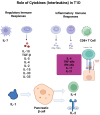Role of Interleukins in Type 1 and Type 2 Diabetes
- PMID: 40804870
- PMCID: PMC12346664
- DOI: 10.3390/diagnostics15151906
Role of Interleukins in Type 1 and Type 2 Diabetes
Abstract
Background: Despite distinct etiologies, type 1 diabetes (T1D) and type 2 diabetes (T2D) share chronic inflammation as a core feature. Interleukins, key immune mediators, play important yet still not fully understood roles in the development and complications of both conditions. Objective: This narrative review aims to provide a comprehensive and critical synthesis of current evidence on the role of key interleukins in T1D and T2D, highlighting their immunological functions, genetic associations, clinical correlations, and translational potential. Methods: A targeted literature search was conducted in PubMed, Google Scholar, and ScienceDirect up to January 2025, focusing on English-language clinical and experimental studies involving interleukins and their relevance to T1D and T2D. Reference lists were manually screened for additional sources. Interleukins (ILs) were reviewed individually to assess their immunobiology, disease specificity, and biomarker or therapeutic value. Findings: Pro-inflammatory cytokines such as IL-1β, IL-6, and IL-17 contribute to islet inflammation, insulin resistance, and microvascular damage in both T1D and T2D. Anti-inflammatory mediators including IL-4, IL-10, and IL-13 exhibit protective effects but vary in expression across disease stages. Less-characterized interleukins such as IL-3, IL-5, IL-9, and IL-27 demonstrate dual or context-dependent roles, particularly in shaping immune tolerance and tissue-specific complications such as nephropathy and neuropathy. Polymorphisms in IL-10 and IL-6 genes further suggest genetic contributions to interleukin dysregulation and metabolic dysfunction. Despite promising insights, translational gaps persist due to overreliance on preclinical models and limited longitudinal clinical data. Conclusions: Interleukins represent a mechanistic bridge linking immune dysregulation to metabolic derangements in both T1D and T2D. While their diagnostic and therapeutic potential is increasingly recognized, future research must address current limitations through isoform-specific targeting, context-aware interventions, and validation in large-scale, human cohorts. A unified interleukin-based framework may ultimately advance personalized strategies for diabetes prevention and treatment.
Keywords: beta-cell dysfunction; cytokines; diabetes mellitus; immunopathogenesis; inflammation; interleukins; type 1 diabetes; type 2 diabetes.
Conflict of interest statement
The authors declare no conflict of interest.
Figures


Similar articles
-
Prescription of Controlled Substances: Benefits and Risks.2025 Jul 6. In: StatPearls [Internet]. Treasure Island (FL): StatPearls Publishing; 2025 Jan–. 2025 Jul 6. In: StatPearls [Internet]. Treasure Island (FL): StatPearls Publishing; 2025 Jan–. PMID: 30726003 Free Books & Documents.
-
Type 1 Diabetes: A Guide to Autoimmune Mechanisms for Clinicians.Diabetes Obes Metab. 2025 Aug;27 Suppl 6(Suppl 6):40-56. doi: 10.1111/dom.16460. Epub 2025 May 15. Diabetes Obes Metab. 2025. PMID: 40375390 Free PMC article. Review.
-
[Guidelines for the prevention and management of bronchial asthma (2024 edition)].Zhonghua Jie He He Hu Xi Za Zhi. 2025 Mar 12;48(3):208-248. doi: 10.3760/cma.j.cn112147-20241013-00601. Zhonghua Jie He He Hu Xi Za Zhi. 2025. PMID: 40050074 Chinese.
-
Interventions to improve safe and effective medicines use by consumers: an overview of systematic reviews.Cochrane Database Syst Rev. 2014 Apr 29;2014(4):CD007768. doi: 10.1002/14651858.CD007768.pub3. Cochrane Database Syst Rev. 2014. PMID: 24777444 Free PMC article.
-
Systemic treatments for metastatic cutaneous melanoma.Cochrane Database Syst Rev. 2018 Feb 6;2(2):CD011123. doi: 10.1002/14651858.CD011123.pub2. Cochrane Database Syst Rev. 2018. PMID: 29405038 Free PMC article.
References
-
- Sun H., Saeedi P., Karuranga S., Pinkepank M., Ogurtsova K., Duncan B.B., Stein C., Basit A., Chan J.C.N., Mbanya J.C., et al. IDF Diabetes Atlas: Global, Regional and Country-Level Diabetes Prevalence Estimates for 2021 and Projections for 2045. Diabetes Res. Clin. Pract. 2022;183:109119. doi: 10.1016/j.diabres.2021.109119. - DOI - PMC - PubMed
-
- Magliano D., Boyko E., IDF Diabetes Atlas 10th Edition Scientific Committee . IDF Diabetes Atlas. 10th ed. International Diabetes Federation; Brussels, Belgium: 2021.
Publication types
Grants and funding
LinkOut - more resources
Full Text Sources

